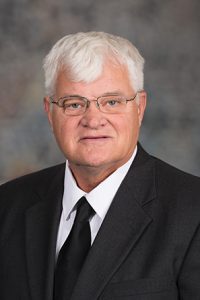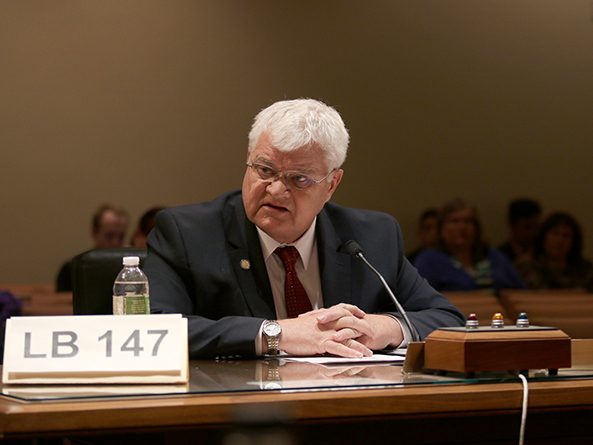Authorized restraint, removal of students considered
The Education Committee heard testimony Feb. 11 on a bill that would give teachers legal protection for defending themselves and others against violent students.
LB147, introduced by North Platte Sen. Mike Groene, would authorize a teacher or administrator to “use the necessary physical contact or physical restraint” to control a student who becomes physically violent toward himself or herself, a teacher, an administrator or another student. Physical contact or restraint also could be used to control a student who “exhibits destructive behavior toward school property.”
A teacher or administrator would not be subject to legal action or administrative discipline if he or she was acting in a reasonable manner.
The bill defines physical restraint as “holding the hands, wrists or torso of a student to control the movements of such student and shall not include the use of any mechanical device or binding a student to any object.”
Groene said case law suggests that teachers may use physical contact short of corporal punishment to preserve order and control the classroom. However, many teachers fear that they could face legal action for physically restraining a child, he said.
“We think that restraining a student by holding their hands, wrists or torso is a reasonable and sufficient way to handle a violent classroom situation,” Groene said, “and putting it into law protects those teachers for doing so.”
The bill also would authorize a teacher to have an administrator, administrator’s designee or school resource officer remove a disruptive student from the classroom under certain circumstances.
The principal could then suspend the student or place the student into another classroom or in-school suspension. The principal could not return the student to the teacher’s class without the teacher’s consent unless the return is required under the Special Education Act or Individuals with Disabilities Education Act.
If the teacher does not consent to the student’s return, the bill would require the teacher, the principal or the principal’s designee, the student and the student’s parent or legal guardian to meet within two days of the removal to determine the causes of the problem and to develop a plan to improve the student’s behavior. The principal then could readmit the student to the teacher’s class.
Maddie Fennell, executive director of the Nebraska State Education Association, testified in support of the bill. She said it would clarify what teachers are allowed to do when students are in danger of harming themselves, others or school property.
“It is prudent to give school personnel the authority to deal with disruptive students while also having protections in place to ensure that those resources are being used prudently or not disproportionately impacting groups of students,” Fennell said.
Kyle McGowan testified in opposition to LB147 on behalf of the Nebraska Council of School Administrators, the Nebraska Rural Community Schools Association and the Nebraska Association of School Boards.
“Ultimately, none of our three organizations want to be on the side of needing more physical restraint,” he said. “We feel that’s the wrong part of the equation.”
McGowan said the bill would invert the current chain of command by allowing a teacher to decide on a student’s removal from the classroom instead of an administrator, reducing a school’s effectiveness.
Also testifying in opposition to the bill was Katie Bevins, president of the Nebraska School Psychologists Association. She said removal from the classroom is contrary to evidence-based discipline strategies and can lead to further behavior problems and low rates of engagement for both students and teachers.
“Unrestricted removals from the class and unsafe practices will not solve the behavioral and mental health crises many of our students experience,” Bevins said.
Juliet Summers of Voices for Children in Nebraska also testified in opposition. She said the bill would disproportionately affect certain groups of students and give teachers “relatively unchecked discretion” for removing students from the classroom.
“Everything we know about disparate discipline suggests that LB147 would lead to more children with disabilities and more children of color removed unfairly from the learning environment without much recourse,” Summers said.
Brad Meurrens, public policy director for Disability Rights Nebraska, also testified in opposition, saying teachers and school staff already have the authority to act as LB147 prescribes. He said the bill could result in more student and staff injuries and contradicts many school districts’ existing restraint and exclusion policies.
“It could send a confusing signal to school personnel about what rules or protocol to follow,” Meurrens said, “and LB147 could persuade schools to dilute their existing restraint policies to match the legislation.”
The committee took no immediate action on the bill.


